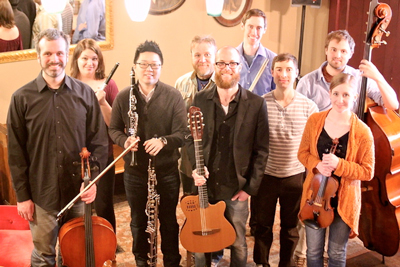by Timothy Robson

The FiveOne Experimental Orchestra (51XO) played a fascinating, meditative — and mostly melodious — program, “Sacrum Silentium” (Latin for “sacred silence”) on Friday, November 13, at the Disciples Christian Church in Cleveland Heights.
The Church seemed an unlikely venue choice, but it was revealed during the course of the concert that the group rehearses regularly there, and the church’s relatively intimate space and resonant acoustic proved ideal. The audience was as eclectic as the music. 51XO normally appears in more unusual venues; their appearance in such a staid venue as a church may attract listeners to some of their more avant-garde events.
The ensemble’s eight musicians arranged themselves in various configurations for the six works on the program. They performed without conductor, but on cues provided by the musicians themselves. Composer Jeremy Allen, Executive Director of 51XO, acted as emcee, introducing each piece. The performers (gleaned, as was the set list, from the 51XO website — there was no printed program) were Audrey Whartenby, flute, James Lee, clarinet, Evan Mitchell, percussion, Rob Kovacs, piano Joshua Stauffer, guitar, Chiara Fasani, violin, Robert Nicholson, percussion, and Tracy Mortimore, double bass.
Canadian composer Jordan Nobles’ Simulacrum (2010) was written to provide the performers with maximum freedom to create new versions at each performance. This version included violin, cello, piano, clarinet, vibraphone, guitar, double bass, and flute. The score consists of multiple musical phrases that the performers use to overlap and respond to each other. The heterophony that ensues is hazy, the same melody repeating across the ensemble in different note values and tempos. At first the cello was in the lead; later the other instruments took over as momentary leaders. The overall result was unearthly, floating through time. This was an example of the benefit of the church’s acoustic. The effect would not have been the same in a smaller, more dry room.
David Crowell’s Like a Machine was energetic and in the minimalist style of composition, although more resembling Steve Reich’s sound world than that of Philip Glass. The texture is complex, with complicated rhythms and surprising grand pauses interspersed throughout. The harmonic structure was very traditionally tonal. 51XO showed their mettle in not just keeping it all together but binding all the parts into an exciting whole.
New York-based Sarah Kirkland Snider’s Pale as Centuries for flute, clarinet, piano, double bass, and amplified acoustic guitar began with a guitar introduction of dissonant chords, leading into a rhythmic ostinato, with swirls of arpeggios traded between the flute and clarinet. Succeeding brief segments allowed for considerable independence among the instruments. As the piece proceeds the pace becomes more frenetic, ending in a shriek. Although the work was technically well-performed, it was musically less cohesive and convincing than the other items on the program.
Jeremy Allen’s Broccoli September was arresting in its beautiful sounds: romantic, with slow, repeated figures in the piano underpinning a haunting clarinet melody. Flute, violin, cello, and bass provide counterpoint along the way, ending in violin harmonics in dialogue with the vibraphone. The piece has an autumnal sound fitting, perhaps, with September. The relationship to broccoli was not revealed. The title was, however, irrelevant. This was the highlight of 51XO’s program.
Continuing with its in-house compositional talent, 51XO’s artistic director John HC Thompson was represented here with a world premiere, Fine. Awful. Whatever. Great for piano, violin, electric guitar, cello and vibes. Thompson’s experience as a jazz musician was evident in the structure of his work. The ensemble introduced the musical material, followed by solos, with a wrap-up by the ensemble. The most complicated work on the program, it was given a virtuosic and compelling performance.
The closing work was 51XO’s own arrangement of the great Estonian composer Arvo Pärt’s slow-moving and austere solo organ work Pari Intervalli (“equal intervals”). The church’s resident organist Adam Kukuk joined the ensemble for the performance. The arrangement parsed Pärt’s intervals into shifting melodic passages traded among the performers. Midway through the piece, repeated notes representing the rhythmic pulse that underlies the piece were introduced, adding a variety of texture. The organ briefly appeared as a solo instrument.
The arrangement was an interesting idea; Pärt himself has transcribed several of his works for various instrumental combinations. The seeming simplicity of Pärt’s music depends, however, upon absolute precision of attack and intonation, which becomes exponentially more difficult the more performers who are involved. The precision might have been improved by using a conductor to more clearly define the pulse. Likewise, the effect of Pärt’s solo organ work is created by the sameness of sound, allowing the listener to focus on the limited harmonic movement. Sometimes a radical rethinking of a work inspires revelation, but this transcription was almost too respectful. I’d like to hear a later version as 51XO settles into their knowledge of the piece.
Published on ClevelandClassical.com November 17, 2015.
Click here for a printable copy of this article



